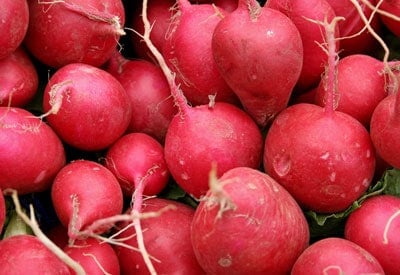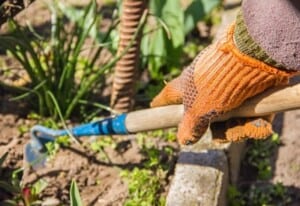Growing radishes is ideal for impatient young gardeners! Radish plants are perfect cool-weather plants that are easy to grow and can be harvested in as little as three weeks.
These potent root vegetables are packed with minerals, dietary fiber, and vitamins C and B6. They are members of the Brassicaceae family, which makes them cousins to cabbage and broccoli.
Radishes (Raphanus sativus) come in two types, the fast-growing and classic salad varieties like French breakfast and early scarlet globe, and winter types like China rose that get larger over the length of an entire season.
Though the classic red radish is what we are most familiar with, many heirloom varieties are available in white, yellow, and even purple.
Peppery or spicy, radishes are everyone’s favorite fresh salad addition.
FREE SHIPPING!
Radish Seeds
Fun Fact: This pungent superfood was given as wages to the ancient Egyptians who built the pyramids.
Botanical Name: Raphanus sativus
Common Name: Radish, common radish, garden radish
Family: Brassicaceae
Plant Type: Vegetable, annual
Hardiness Zones: 2 – 11 (USDA)
Sun Exposure: Full sun
Soil Type: Sandy, loamy, well-drained, moist
Soil pH: 6.0 – 7.0 (Acidic neutral)
Maturity: 22 – 70 days
Height: 4 – 12 inches
Spacing: 8 – 18 inches apart
Quick Guide: Planting, Growing & Harvesting Radishes
- Direct seed this short-season, cool-weather crop in spring or fall
- Plant in loose soil in full sun to partial shade
- Harvest when roots are 1 inch across
- Pests and diseases include flea beetles, cabbage worms, root maggots, clubroot, and fusarium wilt
Affiliate Disclosure: Planet Natural editors review and select each product mentioned in the article independently. If you buy through affiliate links, we may earn a commission which will help support our website.
As an Amazon Associate we earn from qualifying purchases. Some links may be affiliate links. We may get paid if you buy something or take an action after clicking one of these links.
Radish Plant Care
Radishes are a type of annual root vegetable that are a part of the Brassicaceae family, which is also known as the cabbage family. Other members of this family include broccoli, cabbage, cauliflower, kale, collards, and horseradish.
A spicy flavor and a crisp, juicy texture characterize garden radishes. When thinly sliced, they can be put on salads or served with butter and salt, or you can even eat them on their own as a snack.
Radishes can also be roasted whole or cut into cubes, and they can be the base of a soup when pureed.
They can be spherical or carrot-shaped and come in a wide spectrum of colors, including green, white, pink, red, purple, and yellow. If you grow different types of radishes, the harvest times will be spread out, so you will have fresh radishes for weeks.
Light
Radish plants need full sun, which means that on most days they need at least six hours of direct sunlight. Radishes grown in too much shade will focus their energy on growing leaves rather than roots.
Soil
Radishes grow best in rich, loamy, or sandy soil that drains well and has a pH that ranges from slightly acidic to neutral. The soil can’t be too heavy or packed down, or the roots won’t be able to grow well.
Water
On average, radishes require one inch of water per week. The most important thing is to maintain a steady and even level of moisture.
If the soil is too dry, the plant will go to seed and the radishes won’t taste good, and if the soil is too wet, the roots will split and rot. Mulching the soil around your plants is a great way to keep it moist.
Temperature and Humidity
Radishes prefer temperatures in the low 60s but will grow at any temperature between 40 and 70 degrees Fahrenheit.
The plants may bolt and lose quality in hot weather. They can become brittle and woody, or they can become spongy and have hollow centers. In addition, once a radish bolts, the bulb ceases to develop.
As long as the soil stays moist and there is good airflow around the plants, humidity is usually not a problem.
Fertilizer
Radishes usually don’t need to be fertilized if you start with rich soil. Before planting, work a few inches of compost into the soil if your soil needs improving.
Thinning
In the process of growing radishes, thinning is likely the single most important step. Thinning radishes to three-inch spacings is necessary once the seedlings reach 2 inches in height, which is usually around a week after planting.
Radishes that are overcrowded do not grow as well, and the roots that result from this will be small, shriveled, and inedible. Simply snip the greens at the soil line to thin them. These cuttings are edible, so feel free to toss them in a salad.
The other option is to replant thinnings that have been carefully removed without damaging the roots, leaves, or stem. Although transplants may be experiencing some stress, they should be able to recover. At the time of thinning, pull any weeds that have appeared in the row.
How to Plant and Grow Radishes
Site Preparation
Radish plants grow best in the spring and autumn and will tolerate light winter frosts. They require full to partial sun (most guides recommend at least 6 hours), ample water, and rich, fast-draining soil.
Loosen the soil to a depth of 8 inches or even more and work in at least 10 pounds of good organic compost per 100 square feet. You can also add a little sand to improve drainage and friability.
Radishes like plenty of phosphorous so if you intend to add fertilizer before sowing, use something like bone meal.
Too much nitrogen will encourage heavy top growth and discourages root bulbs. Kelp meal is loaded with micronutrients and will supply trace minerals to crops that will be consumed.
How to Plant Radishes
Sow seeds directly in the garden, 1/2 inch deep, as soon as you can work the soil. Plant weekly to spread out the harvest over weeks, not days.
Space rows 8-18 inches apart, planting eight to ten seeds per foot. Thin to one plant every 2 inches.
Once planted, keep garden areas cool and well-mulched with compost or aged animal manure. High temperatures and drought make this root crop tough, strong tasting, and prone to insect problems (see Growing the Perfect Radish). Do NOT allow the soil to dry out.
Types of Radish Seeds to Plant
You can grow many different kinds of radish seeds in your garden. Your flavor and color preferences will guide your decision regarding which variety to select.
Make sure to try a few to see which ones you like best, or get a mixed seed packet. Here are a few of our personal favorites.
Companion Planting
Radishes, like marigolds, are an excellent all-purpose insect repellent in the garden. When planted in close proximity to beans, beets, chervil, cucumbers, lettuce, mint, parsnips, peas, spinach, squash, and tomatoes, they prove to be an advantageous companion crop.
They are occasionally used with onions as a trap plant to draw out root maggots. Radishes utilized in this manner must be discarded when onions are harvested.
Most pests that like to eat squash and cucumbers will stay away if you plant half a dozen icicle radishes around them and let them grow and bloom.
Seed Saving Instructions
Plants will cross-pollinate and must be isolated by 1/2 mile or planted in insect-proof cages covered with a screen. Seed stalks can be 3 feet tall.
Always discard the early bolting plants, since they are not the best to save for seed. The seed stalk is harvested when the stalk and pods are dry. Seeds can then be separated by hand.

How to Harvest Radishes
Harvest radishes when they are of usable size and relatively young. Look for bulbs that are an inch in diameter and slightly poking through the soil.
When harvesting radishes, it’s important to know what type of radish you’re growing. For that, check your radish seed packet! This is because different types of radishes have different grow times.
Check often, as they can turn from tasty to terrible (pithy and spongy) in a short period of time. Spring varieties mature in 3-5 weeks. Winter types mature in 55-60 days.
For the best flavor, harvest in the morning, rinse, and eat fresh. If this is not possible, store the unwashed roots — leafy greens removed — inside a plastic bag and keep them in the produce drawer of your refrigerator for up to 2 weeks.
Common Pests and Plant Disease for Radishes
Radish plants are related to cabbage and suffer from many of the same problems. Since leaves are not harvested, more insect damage can be tolerated on foliage than other vegetable crops.
If holes or tunnels are found in the bulbs, suspect root maggots and treat them using proven organic techniques.












